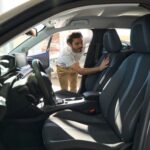In a world where innovation and tech upgrades dominate nearly every purchase decision, it seems almost paradoxical that something as glamorous as a brand-new car is losing its appeal. Yet here we are—facing an era where buyers are second-guessing that dealership visit, and headlines everywhere are asking the same bold question: why no one wants a new car now.
It’s not a passing trend or a one-off blip. It’s a complex web of shifting priorities, financial pressures, and evolving consumer attitudes. And if you’re still wondering whether this phenomenon is exaggerated, let’s break down exactly why this sentiment is taking root—and spreading fast.
The Cost of a Dream is Becoming a Nightmare
For decades, owning a new car was a rite of passage. The scent of fresh leather, the gleaming dashboard, the flawless exterior—it symbolized success, freedom, and modern living. But today, that dream has become a financial burden for many.
The cost of new vehicles has soared beyond what the average consumer finds justifiable. Inflation, supply chain issues, and increased production costs have pushed prices to eye-watering levels. When you’re staring down a $50,000 sticker for what used to be a $30,000 car just a few years ago, it’s easy to see why enthusiasm has waned. Add high-interest auto loans to the mix, and suddenly, the fantasy of cruising off the lot in a brand-new ride turns into a monthly payment that rivals a mortgage.
Used Cars Are No Longer the Underdog
The resurgence of the used car market has added another twist to the narrative. It’s not just about affordability—though that’s a huge part of the equation. Today’s used cars are built better, last longer, and come packed with features that, not long ago, were only reserved for luxury models.
Why settle for a stripped-down base model of a new vehicle when a certified pre-owned version of last year’s SUV offers more comfort, performance, and tech at a fraction of the price? Consumers are realizing that buying used doesn’t mean compromising—it means being savvy.
Tech Overload and Feature Fatigue
Once upon a time, car technology meant power windows and anti-lock brakes. Now, cars practically double as smartphones on wheels. While some buyers love this, others are suffering from feature fatigue. Lane-assist warnings, voice controls, gesture-based infotainment systems—great in theory, but they’re not always intuitive or reliable.
This overload has caused many to crave simplicity. People are turning away from new models not because they dislike technology, but because they feel overwhelmed by it. When drivers are spending more time figuring out how to turn off an overly sensitive parking sensor than actually enjoying the ride, the novelty wears off fast.
The Maintenance Myth and the Reliability Reality
Manufacturers have long promoted new cars as maintenance-free for years. But with modern vehicles becoming increasingly complex, servicing them has turned into a costlier and more specialized affair. Even a basic repair can require proprietary diagnostics or hard-to-find parts.
Older vehicles, in contrast, have proven their reliability. Their mechanical systems are easier to maintain, and parts are often more accessible. Many consumers now believe that holding onto a dependable used car for a few more years is a smarter, less stressful move—especially when compared to dealing with unexpected costs associated with high-tech new models.
Environmental Awareness and the Rise of Sustainable Choices
Another reason why no one wants a new car now is rooted in growing environmental consciousness. Mass-producing new vehicles, especially ones with massive batteries or large engines, leaves a substantial carbon footprint. More buyers are considering the environmental cost of consumption, opting instead to extend the life of existing vehicles rather than contribute to the production demand of new ones.
The rise of shared mobility services and improvements in public transportation also play a part. People are weighing the long-term environmental and financial impact of car ownership and finding alternative ways to get around.
Electric Cars: The Future That’s Not Quite There Yet
Electric vehicles have been hyped as the future of driving—and rightfully so. But for all their promise, the EV market is still in a transition phase. Charging infrastructure isn’t widespread enough, battery technology is improving but still imperfect, and prices remain high.
Consumers who might’ve been tempted to buy a new EV are hesitating. They’re waiting for better range, faster charging, more models, and lower prices. In the meantime, they’d rather stick with what they know than invest in an uncertain technology that’s not quite matured.
Delayed Gratification in an Uncertain World
Perhaps one of the most telling reasons why no one wants a new car now is rooted in psychology. The pandemic, followed by economic turbulence, has fundamentally changed how people view spending. There’s a newfound emphasis on financial security and mindful consumption. Flashy purchases don’t carry the same allure when economic unpredictability is the backdrop of everyday life.
People are learning to delay gratification. That shiny new car can wait—especially when the current one runs just fine. This mindset shift doesn’t mean folks won’t ever buy new cars again, but right now, caution and practicality are driving decisions more than desire.
Conclusion: The Road Ahead
The reasons behind why no one wants a new car now are layered and multifaceted. It’s not about a sudden distaste for automobiles but rather a larger cultural shift. People are becoming more financially savvy, environmentally aware, and less swayed by status symbols. They’re questioning the value behind the purchase, looking beyond the showroom shine, and choosing options that align with their real-life needs and values.
As manufacturers respond to this evolving landscape, we may see more affordable models, simplified tech interfaces, and greener production processes. But until then, consumers are making their voices heard—not through words, but through the decision to hold the keys a little longer before trading them in.



